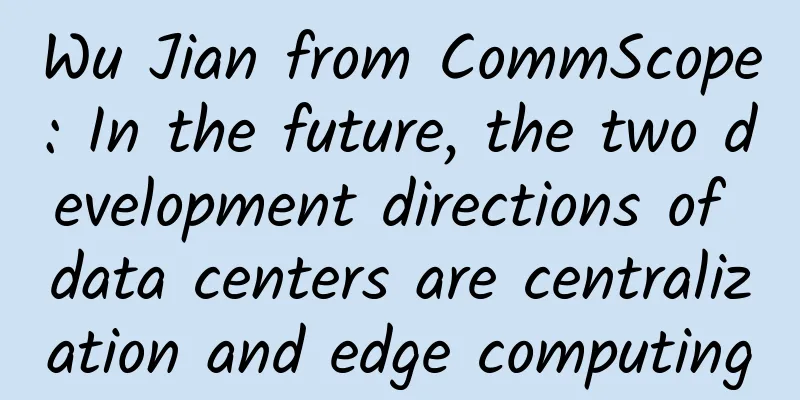Wu Jian from CommScope: In the future, the two development directions of data centers are centralization and edge computing

|
【51CTO.com original article】 Do you know how much happens on the Internet every minute? People search online 2.4 million times, send 150 million emails, and watch nearly 70,000 hours of streaming video every minute. In China, people conduct 4.2 million Baidu searches and use Alipay to make 122,000 online transactions every 60 seconds. Global demand for bandwidth is growing exponentially "This situation will not change in the short term," Wu Jian, technical director of CommScope North Asia, told reporters in an interview: "In the era of the Internet of Everything, the global demand for bandwidth is growing exponentially. In particular, the demand for bandwidth capacity for video will continue to grow. It is estimated that by 2019, the Internet traffic generated by online videos will account for more than 80% of the total Internet traffic."
Wu Jian, Technical Director of North Asia, CommScope “We are rapidly transitioning from 10Gb/s and 40Gb/s to 100Gb/s, 400Gb/s and higher speeds,” said Lan Chen, vice president of sales for Enterprise Networks North Asia at CommScope. “Speed is a key requirement as the data demanded by consumers and network users is proportional to the services they expect. This is both a global phenomenon and one of the biggest challenges facing data center designers and builders.” Faced with huge traffic challenges and increasing pressure on bandwidth demand, enterprise data center infrastructure urgently needs to be adjusted, and data center teams expect to increase the number of equipment ports and fiber density, support faster channel rates, reduce latency, and prepare for migration to higher speeds. This requires that network infrastructure, whether for enterprises, multi-tenants or cloud service providers, must be more agile and flexible, seamlessly adapt to new applications and unknown changes in the future; achieve high density and low loss to keep the expanding optical fiber network manageable without sacrificing the signal performance required to support higher channel speeds; and support cloud and virtualization, capacity planning and deployment, and strategy to reduce costs and network complexity. However, it is easier said than done. CommScope launches high-speed network upgrade platform to cope with future bandwidth growth In order to build a network that can meet the needs and solve the challenges of network upgrades. As a provider of communication network infrastructure solutions, CommScope has launched the HSM high-speed network upgrade platform. The high-speed network upgrade platform is a full set of product portfolios formed by integrating and upgrading products based on CommScope's years of technological advantages and understanding of user needs. The platform can be used for duplex and parallel applications, allowing customers to decide the best architecture. And the platform can support higher speeds and emerging applications without disassembling and replacing the basic framework. Wu Jian said: "It is not only an innovative infrastructure solution, but also a long-term and reliable strategy. It can meet the company's network upgrade needs at any time." He said that the advantages of the high-speed network upgrade platform are: intelligent management, high performance, low loss, high density, and modularity. Among them, the intelligent management of the high-speed network upgrade platform is mainly based on software implementation. Take a common problem as an example, how to organize the cables in the cabinet? The traditional method mainly has three steps: First, the wires should be made thin. Second, large cabinets and racks should be selected. Third, after selecting an appropriate cabinet, vertical cable organizers or horizontal cable organizers should be added to it. Generally speaking, doing these three steps can solve the problem of cable congestion. However, when the cables are very dense, it is difficult for us to tell where the cables are connected and which specific cable has a problem. Because the wiring has no signal, it cannot convey which U position of which rack and which port has a problem. The intelligent wiring in the high-speed network upgrade platform can solve this problem and help enterprises realize intelligent management. In order to allow the wiring to have a signal, CommScope densely installs sensors on each port on the wiring connection patch panel, and receives the sensor signal in combination with the software in the platform to monitor the status of each port. If a port has a problem, the computer terminal can accurately determine the location and solve it in time. The relationship between green and energy-saving data centers and cabling When asked by reporters how the high-speed network upgrade platform can reduce data center losses, Wu Jian explained that this starts with the relationship between green and energy-saving data centers and cabling. Many people think that achieving energy conservation is related to power distribution, refrigeration, UPS, etc., and what does cabling have to do with it. In fact, green and energy-saving data centers are also closely related to cabling: ***, optical fiber is more energy-efficient than copper cable. The deployment of a large number of optical fibers can reduce IT energy consumption. Although optical interfaces are sometimes more expensive than copper interfaces, they have a larger flow rate. Therefore, the use of optical fibers is more, which is one of the manifestations of green energy conservation. Second, in the same space, high density means high energy efficiency and utilization. A large computer room has several servers, and power distribution, refrigeration, etc. are all required. This means that the utilization rate is very low and energy-saving. Make full use of the infrastructure and improve utilization efficiency to achieve energy saving. So high density is actually a manifestation of energy saving. Third, using thinner cables for open wiring is a very important energy-saving method. Open wiring is conducive to the establishment of hot and cold channels and the optimization and organization of airflow in most data centers now, so open wiring is particularly conducive to green energy saving in data centers. Fourth, reduce operating costs. Using intelligent cabling products can help users reduce operation and maintenance problems, which is also an important manifestation of green energy saving and cost reduction in data centers. In the future, the two development directions of data centers are centralization and edge computing. In an interview with ***, regarding the future development direction of data centers, Wu Jian believes: "There are two development directions for data centers: one is more centralized, and the other is edge computing. These are two different interpretations and angles of technology. In the future, the amount of data generated by network applications will be astonishing. We can see that there are actually further requirements for the energy efficiency and efficiency of data center computing, which means you need to build a more efficient data center." He said: "China's population is four times that of the United States, and the number of servers owned by the United States is four times that of China. If we look at these two data on a per capita basis, our development is only 1/16 of that of the United States, so I am very optimistic about the use of data centers. We look forward to China's data centers taking another step forward." [51CTO original article, please indicate the original author and source as 51CTO.com when reprinting on partner sites] |
<<: Improving the value of colocation data centers with DCIM
>>: Without big data and artificial intelligence, you may not be able to eat if you are hungry
Recommend
What will the future world look like under the 5G technology revolution?
Some time ago, Huawei's "Intelligent Wor...
Virtual operators in the 5G era: new opportunities and challenges coexist
The 5G era will bring differentiated intelligent ...
Transforming the network to support remote work as a norm
Before the COVID-19 pandemic, remote work was mor...
How eSIM is revolutionizing wireless technology
Embedded Subscriber Identity Modules (eSIMs) have...
To prevent 5G from the barrel effect, both Sub-6GHz and millimeter wave are indispensable
The wooden barrel effect is a well-known truth. 5...
[Black Friday] Digital-vm offers 40% off, 1-10Gbps VPS in the US/Japan/Singapore and other data centers starting at $2.4 per month
Digital-vm sent an email about 40% Discount Black...
What is fog computing and how does it relate to the Internet of Things?
Fog computing is a distributed collaborative arch...
Network Automation: The Core Competitiveness of Operators in the 5G Era
[[327272]] What is the core competitiveness of op...
NASA thinks the moon will soon have its own internet
It's been nearly 50 years since astronauts la...
Verizon expands Ultra Wideband 5G and 5G Home Internet to new cities
Verizon, the US telecom operator, recently announ...
H3C wins bid for Qingdao Metro to boost the development of Qingdao's urban rail transit
Recently, New H3C Group, a subsidiary of Tsinghua...
Is the expansion speed of WiFi 6 really much faster than 5G?
In daily life, we may encounter the following sit...
The greater development of 5G lies in industrial applications
[[181724]] Some people say that 4G has changed ou...
How many meters can a network cable transmit at most? Several common classifications of network cables
Maximum distance of data transmission via network...
5G Network as a Service (NaaS): How 5G enables telecom operators to monetize their networks
5G provides a large number of new applications fo...









